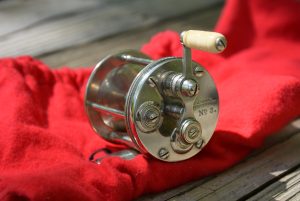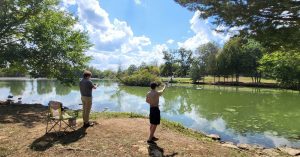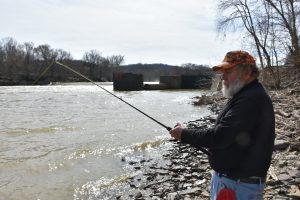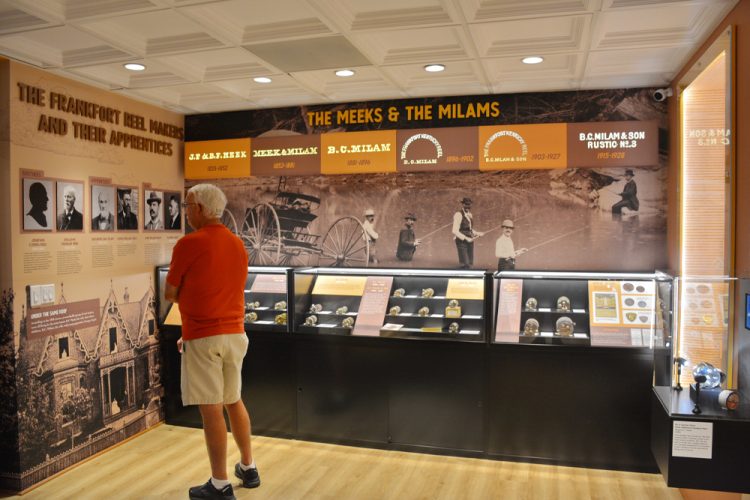A guest views part of the display in the Capital City Museum in Frankfort, Kentucky. This museum has one of the largest collections of Kentucky or Frankfort reels in the nation. There are also lures and other items of interest to anglers of all ages. (Richard Hines photo)
Old Reels, Channel Cats and a Bourbon Tour in Kentucky
By Richard Hines
If you are traveling, this summer might be time to see what Kentucky has to offer. Why Kentucky? Well, if you are an angler, you should know Kentucky has more miles of navigable water than any state except Alaska. In other words, no matter what your destination, fishable water is close by.
Kentucky also has a wide range of other attractions, from the Ark Encounter to horse farms, train rides, caves, beautiful gorges with picturesque streams and the Bourbon Trail. A great place to start your Bluegrass State visit is Frankfort, which provides unique sites many anglers will enjoy, not to mention a good chance of catching a catfish.
Stop #1: Capital City Museum

Frankfort, the capital city of Kentucky, might not be a town you associate with fishing reels, but the multiplying baitcasting reels we use today were invented there. Known as Kentucky or Frankfort reels, they were first built around 1830 by two watchmakers, B.F. Meek and B.C. Milam, and were a major improvement over the original fishing reels designed in England, which only had a 1:1 gear ratio. The newer Kentucky reels had a 4:1 ratio.
Anglers stood in line for the chance to buy the solid-brass and German silver reels. The reels were so valuable that there are accounts of Kentucky reels being willed to friends and family. One Kentucky reel was passed on to President Grover Cleveland from Joseph Jefferson, the most famous stage actor of the late 1800s. You can see one of the best collections in the country at the Crafting & Casting exhibit in the Capital City Museum in Frankfort.
Stop #2: Buffalo Trace Distillery

One of Kentucky’s most famous products, bourbon, is the result of the water coming from the surrounding limestone bluffs, and if you are planning to visit, you might want to sample some of that bourbon, or see how it’s made, at Buffalo Trace Distillery in Frankfort. This distillery, the nation’s oldest, dates back to 1775 and is on the National Historic Register. A wide range of complimentary tours and tastings are offered.
Currently, Buffalo Trace is aging over 200,000 barrels of various bourbons. A complimentary tour to see the operations and learn about the facility’s history is definitely worth your time.
Stop #3: Salato Wildlife Education Center

There are several places where you can catch catfish around Frankfort, including the Salato Wildlife Education Center within minutes of downtown. Located adjacent the headquarters for the Kentucky Department of Fish and Wildlife, this property encompasses two beautiful lakes that are open from dawn until dusk seven days a week year-round. Both are routinely stocked with channel catfish, and it’s not unheard of for guests to catch some whiskerfish in the 8-to-10-pound range! Access to the lakes is easy, making this a perfect location to take the kids.
While you’re there, check out some of the center’s other educational attractions, including the warm-water aquarium, the monarch butterfly waystation, live animal exhibits (alligator snapping turtle, snakes, deer, elk, raptors and more) and four miles of trails for all levels of hikers. Covered picnic shelters and open-air picnic tables, all with charcoal grills, are conveniently located between the Salato Center and the large fishing lake.
Stop #4: Kentucky River Lock and Dam #2
If you don’t mind walking on rough ground along a riverbank, take a 35-minute drive north of Frankfort to the Kentucky River Lock and Dam #2 located at Lockport. This dam was built by the Corps of Engineers in 1836 and is still operated by the state of Kentucky.

When visiting there, I always like to think about the many anglers who have fished below the dam during the 89 years it has been there. I wonder how many anglers stood at this identical location and watched paddlewheel steamboats plying their way upstream from Louisville or Cincinnati as they traveled to Frankfort. Today we imagine those steamboats as being much larger, but when you look at the lock and realize that those boats fit into that lock as they were raised into the next pool above the dam, you realize they weren’t really that large.
Lockport is in neighboring Henry County, and there are few amenities there except for Ace’s Grocery, a good place to get a sandwich and drink, and only a couple of minutes from the lock parking lot. When you park along the lock wall, you will see a rock trail leading down the hill to the riverbank. It is by no means a simple walk, so wear some good shoes and be careful as the footing is rough.
You will find plenty of places to fish along the bank, and the water is usually not terribly swift. I usually fish with a 1- or 2-ounce weight to hold some type of cut-bait on the bottom. If you like fishing rivers, this is a good location to spend the morning or afternoon catfishing. You won’t find a lot of good “rock seats” on-site, so bring a folding chair.
Benjy Kinman Lake
If you find fishing a little slow at Lockport, it’s only a few minutes north via Highway 389 to the Kentucky River Wildlife Management Area. Watch for a sign indicating a boat ramp, which is on Benjy Kinman Lake, an old oxbow of the Kentucky River. This 88-acre lake has two boat ramps, and there is also a handicap-accessible fishing pier. It’s a great location to take the kids where they can safely fish. Or try for some kitty cats yourself. There are good numbers of channel catfish over 15 inches, and trophy-sized fish are present. There is also a small population of flathead catfish.
If any of these things don’t sound interesting, did I mention raft and kayaking trips on Elkhorn Creek, river tours, the Pete Pfeiffer Fish Hatchery or visiting Daniel Boone’s grave at Frankfort Cemetery? As you can see, there’s much more to Frankfort, Kentucky than most people could imagine. For more information, go to VisitFrankfort.com.
(Richard Hines is a retired wildlife biologist, book author and award-winning freelance outdoor writer and photographer. Since 1985, Hines has published hundreds of articles on hunting, fishing, conservation and natural history. He and his wife Pam enjoy traveling where they are rarely without fishing rods. To date Hines has fished in 37 states and counting.)



